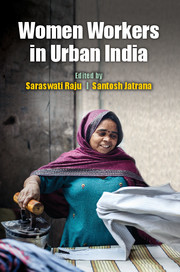Book contents
- Frontmatter
- Contents
- List of Figures
- List of Tables
- Preface
- 1 Setting the Backdrop
- 2 Women Workers in Urban India and the Cities
- 3 Gendered Vulnerabilities: Work-Life Trajectories of Female Domestic Workers in Jaipur
- 4 Occupational Domestication in a Post-Resettlement Context: An Analysis of Women's Work in Kannagi Nagar, Chennai
- 5 Old Jobs in New Forms: Women's Experiences in the Housekeeping Sector in Pune
- 6 Persistent Inequalities and Deepened Burden of Work? An Analysis of Women's Employment in Delhi
- 7 Spare Change for Spare Time? Homeworking Women in Banaras
- 8 Gender, Work and Space: Home-based Workers in Garment Industry in Kolkata
- 9 Labour Control and Responses: Women Workers in an Apparel Park in Kerala
- 10 New Urban Economic Spaces and the Gendered World of Work in Kolkata
- 11 Gender Equality and Women's Employment in the Banking Sector in India
- 12 Women Body Screeners and the Securitization of Space in Indian Cities
- Notes on Contributors
- Index
9 - Labour Control and Responses: Women Workers in an Apparel Park in Kerala
Published online by Cambridge University Press: 05 May 2016
- Frontmatter
- Contents
- List of Figures
- List of Tables
- Preface
- 1 Setting the Backdrop
- 2 Women Workers in Urban India and the Cities
- 3 Gendered Vulnerabilities: Work-Life Trajectories of Female Domestic Workers in Jaipur
- 4 Occupational Domestication in a Post-Resettlement Context: An Analysis of Women's Work in Kannagi Nagar, Chennai
- 5 Old Jobs in New Forms: Women's Experiences in the Housekeeping Sector in Pune
- 6 Persistent Inequalities and Deepened Burden of Work? An Analysis of Women's Employment in Delhi
- 7 Spare Change for Spare Time? Homeworking Women in Banaras
- 8 Gender, Work and Space: Home-based Workers in Garment Industry in Kolkata
- 9 Labour Control and Responses: Women Workers in an Apparel Park in Kerala
- 10 New Urban Economic Spaces and the Gendered World of Work in Kolkata
- 11 Gender Equality and Women's Employment in the Banking Sector in India
- 12 Women Body Screeners and the Securitization of Space in Indian Cities
- Notes on Contributors
- Index
Summary
Introduction
Prior to the 1970s, firms in the stable markets, essentially producing for masses, competed by improving productivity, decreasing costs, along with expanding market share within the existing markets (Benner 2002). However, of late, the ability of firms to adapt to changing market conditions, identifying new opportunities, and successfully meeting challenges, has gained importance for not just competitive advantage but also for economic survival. These changes have created an entirely different political—economic environment for workers around the world and the labour market has been radically restructured. More than simply reducing wages in a ‘race to the bottom’, there has been the apparent move away from regular employment towards part-time, temporary, or subcontracted work arrangements (Neethi 2008). Employers have cashed in on weakened union powers and pools of surplus (unemployed or underemployed) labour, advocating flexible work regimes and labour contracts; for regular employees, too, longer working hours during peak demand and shorter hours during periods of slack are becoming common (Milberg 2004). Workers are thus put at an immediate disadvantage in terms of bargaining power with the owners of capital and with respect to the State (Milberg 2004).
All these effects are doubly obvious when we consider the transformed role of women in production and labour markets. Not only do new labour market structures facilitate exploitation of the labour power of women on a part-time basis, and substitution of lower-paid female labour for that of more highly paid and less easily laid-off core male workers, the revival of subcontracting and domestic/family labour systems also permits a resurgence of patriarchal practice and home working (Harvey 1990, 1991; Harvey and Scott 1989). A preference for women exists, as it brings with it reduced costs of production, reduced probabilities of the threat of unionisation, possibilities to avoid providing of minimal standards of decency and safety at work required by labour laws and to ignoring pay levels stipulated in minimum wage laws and prevention of access to social security (Harriss-White 2010). Women workers thus seem to stand at the trafficked crossroads of class and gender (Beneria and Roldan 1987). As a consequence, women are employed in simple, unskilled, labour-intensive tasks of assembly or finishing, requiring minimum use of capital or production tools.
- Type
- Chapter
- Information
- Women Workers in Urban India , pp. 228 - 255Publisher: Cambridge University PressPrint publication year: 2016

